Citroen GRAND C4 PICASSO RHD 2017 2.G Owner's Manual
Manufacturer: CITROEN, Model Year: 2017, Model line: GRAND C4 PICASSO RHD, Model: Citroen GRAND C4 PICASSO RHD 2017 2.GPages: 523, PDF Size: 11.96 MB
Page 131 of 523

129
Switching the ignition on
(without starting)
With the ignition on, the system goes
into energy economy mode when
necessary to maintain the state of
charge of the battery.
With the electronic key in the reader or the
Keyless Entry and Starting key inside the
vehicle, pressing the "START/STOP" button,
with no action on the pedals
, allows the
ignition to be switched on.
F
P
ress the "START/STOP" button,
the instrument panel comes on
but the engine does not start.
F
P
ress the button again to switch off the
ignition and so allow the vehicle to be
locked.
Anti-theft protection
Electronic engine immobiliser
The keys contain an electronic chip which has
a secret code. When the ignition is switched
on, this code must be recognised in order for
starting to be possible.
This electronic engine immobiliser locks the
engine management system a few minutes
after the ignition is switched off and prevents
starting of the engine by anyone who does not
have the key.
In the event of a malfunction, you are informed
by a message in the instrument panel screen.
In this case, your vehicle does not start; contact
a CITROËN dealer if required.
4
Driving
Page 132 of 523

130
Electric parking brake
In the event of a battery failure, the
electric parking brake no longer works.
As a safety measure, if the parking
brake is not applied, immobilise the
vehicle by engaging a gear (with a
manual gearbox) or placing a chock at
one of the wheels.
Contact a CITROËN dealer or a
qualified workshop.
Indicator lamp
This indicator lamp comes on in the
instrument panel and in the control
lever to confirm the application of the
parking brake.
The system provides, in automatic operation,
the application of the parking brake on
switching off the engine and release as the
vehicle moves off.
The driver can take over at any time to apply
or release the parking brake, by operating the
control lever:
-
b
y briefly pulling the control lever to apply
the brake,
-
b
y briefly pushing the control lever, while
pressing the foot brake, to release.
Automatic mode is activated by default.
The technology adopted for the electric
parking brake does not allow the fitment
of 15 inch wheels. It goes off to confirm the release of the parking
brake.
The indicator lamp in the control lever flashes
during manual application or release.
After the parking brake has been applied, the
simultaneous flashing of the two indicator
lamps in the instrument panel and the control
lever alerts you to the need to fully secure your
vehicle by engaging a gear (with a manual
gearbox) or by placing the gear selector
in position P with an automatic gearbox,
or by fitting a chock to one of the wheels.
(E.g.
parking on a very steep slope or on a
slope with a low battery).
Driving
Page 133 of 523
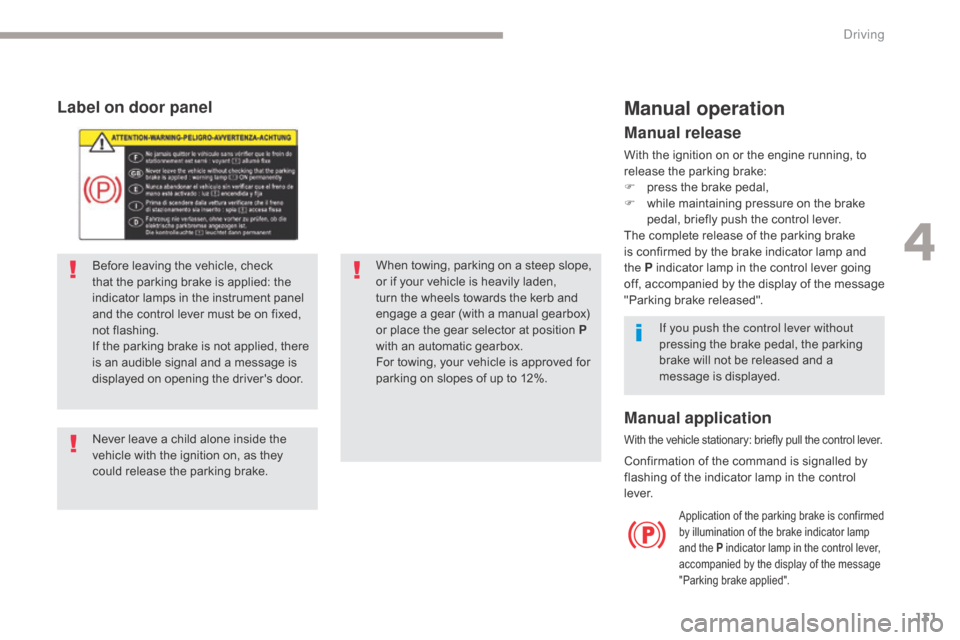
131
Label on door panel
Before leaving the vehicle, check
that the parking brake is applied: the
indicator lamps in the instrument panel
and the control lever must be on fixed,
not flashing.
If the parking brake is not applied, there
is an audible signal and a message is
displayed on opening the driver's door.
Never leave a child alone inside the
vehicle with the ignition on, as they
could release the parking brake.When towing, parking on a steep slope,
or if your vehicle is heavily laden,
turn the wheels towards the kerb and
engage a gear (with a manual gearbox)
or place the gear selector at position
P
with an automatic gearbox.
For towing, your vehicle is approved for
parking on slopes of up to 12%.
Manual operation
Application of the parking brake is confirmed
by illumination of the brake indicator lamp
and the
P indicator lamp in the control lever,
accompanied by the display of the message
"Parking brake applied".
Manual release
With the ignition on or the engine running, to
release the parking brake:
F
p
ress the brake pedal,
F
w
hile maintaining pressure on the brake
pedal, briefly push the control lever.
The complete release of the parking brake
is confirmed by the brake indicator lamp and
the
P indicator lamp in the control lever going
off, accompanied by the display of the message
"Parking brake released".
If you push the control lever without
pressing the brake pedal, the parking
brake will not be released and a
message is displayed.
Manual application
With the vehicle stationary: briefly pull the control lever.
Confirmation of the command is signalled by
flashing of the indicator lamp in the control
l eve r.
4
Driving
Page 134 of 523
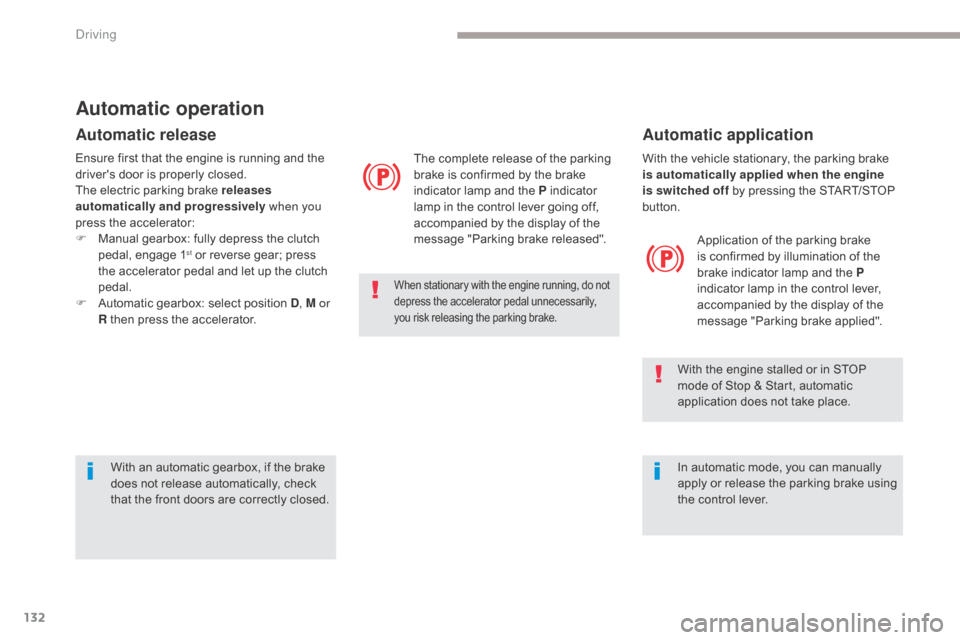
132
With the vehicle stationary, the parking brake
is automatically applied when the engine
is switched off by pressing the START/STOP
button.Application of the parking brake
is confirmed by illumination of the
brake indicator lamp and the P
indicator lamp in the control lever,
accompanied by the display of the
message "Parking brake applied".
With the engine stalled or in STOP
mode of Stop & Start, automatic
application does not take place.
In automatic mode, you can manually
apply or release the parking brake using
the control lever.
Automatic operation
Automatic release
The complete release of the parking
brake is confirmed by the brake
indicator lamp and the P indicator
lamp in the control lever going off,
accompanied by the display of the
message "Parking brake released".
When stationary with the engine running, do not
depress the accelerator pedal unnecessarily,
you risk releasing the parking brake.
Ensure first that the engine is running and the
driver's door is properly closed.
The electric parking brake releases
automatically and progressively when you
press the accelerator:
F
M
anual gearbox: fully depress the clutch
pedal, engage 1
st or reverse gear; press
the accelerator pedal and let up the clutch
pedal.
F
A
utomatic gearbox: select position D , M or
R then press the accelerator.
Automatic application
With an automatic gearbox, if the brake
does not release automatically, check
that the front doors are correctly closed.
Driving
Page 135 of 523
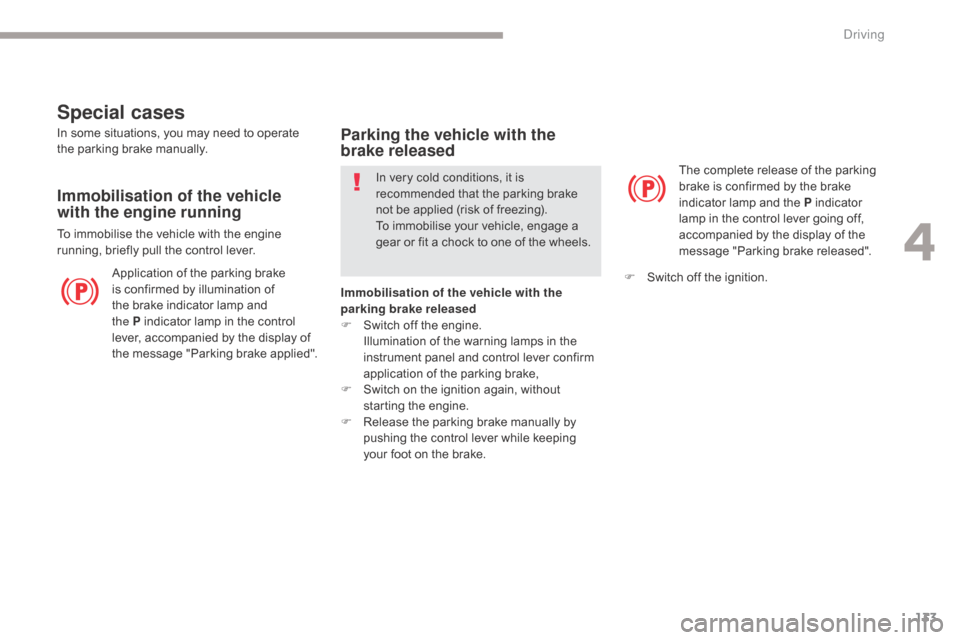
133
Special cases
Application of the parking brake
is confirmed by illumination of
the brake indicator lamp and
the P indicator lamp in the control
lever, accompanied by the display of
the message "Parking brake applied". The complete release of the parking
brake is confirmed by the brake
indicator lamp and the P indicator
lamp in the control lever going off,
accompanied by the display of the
message "Parking brake released".
In some situations, you may need to operate
the parking brake manually.
Immobilisation of the vehicle
with the engine running
To immobilise the vehicle with the engine
running, briefly pull the control lever.
Parking the vehicle with the
brake released
In very cold conditions, it is
recommended that the parking brake
not be applied (risk of freezing).
To immobilise your vehicle, engage a
gear or fit a chock to one of the wheels.
Immobilisation of the vehicle with the
parking brake released
F
S
witch off the engine.
I
llumination of the warning lamps in the
instrument panel and control lever confirm
application of the parking brake,
F
S
witch on the ignition again, without
starting the engine.
F
R
elease the parking brake manually by
pushing the control lever while keeping
your foot on the brake. F
S
witch off the ignition.
4
Driving
Page 136 of 523
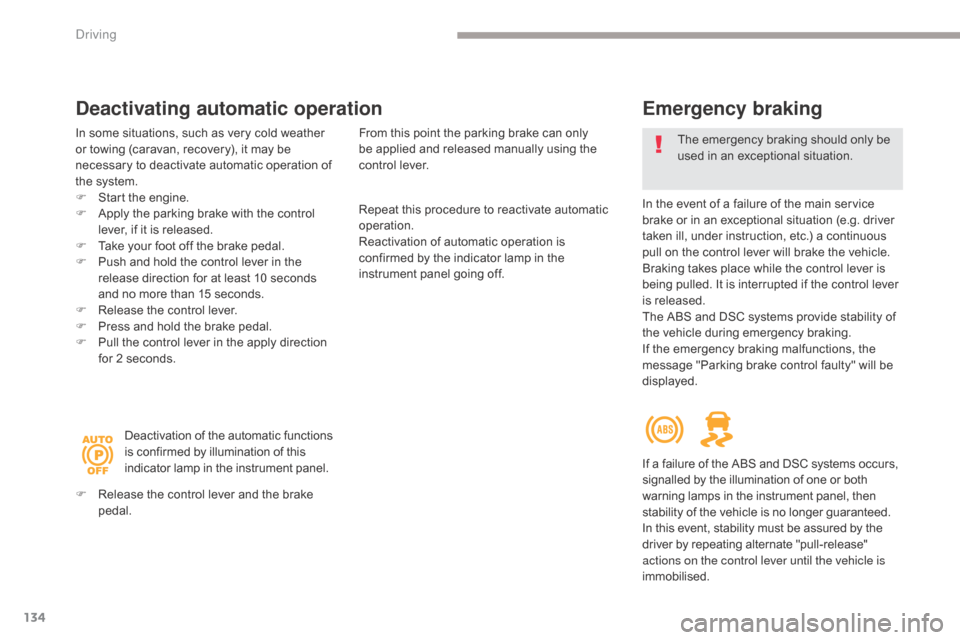
134
Emergency braking
In the event of a failure of the main service
brake or in an exceptional situation (e.g. driver
taken ill, under instruction, etc.) a continuous
pull on the control lever will brake the vehicle.
Braking takes place while the control lever is
being pulled. It is interrupted if the control lever
is released.
The ABS and DSC systems provide stability of
the vehicle during emergency braking.
If the emergency braking malfunctions, the
message "Parking brake control faulty" will be
displayed.
If a failure of the ABS and DSC systems occurs,
signalled by the illumination of one or both
warning lamps in the instrument panel, then
stability of the vehicle is no longer guaranteed.
In this event, stability must be assured by the
driver by repeating alternate "pull-release"
actions on the control lever until the vehicle is
immobilised.The emergency braking should only be
used in an exceptional situation.
Repeat this procedure to reactivate automatic
operation.
Reactivation of automatic operation is
confirmed by the indicator lamp in the
instrument panel going off.
Deactivating automatic operation
In some situations, such as very cold weather
or towing (caravan, recovery), it may be
necessary to deactivate automatic operation of
the system.
F
S
tart the engine.
F
A
pply the parking brake with the control
lever, if it is released.
F
T
ake your foot off the brake pedal.
F
P
ush and hold the control lever in the
release direction for at least 10 seconds
and no more than 15 seconds.
F
R
elease the control lever.
F
P
ress and hold the brake pedal.
F
P
ull the control lever in the apply direction
for 2 seconds.
Deactivation of the automatic functions
is confirmed by illumination of this
indicator lamp in the instrument panel.
F
R
elease the control lever and the brake
pedal. From this point the parking brake can only
be applied and released manually using the
control lever.
Driving
Page 137 of 523
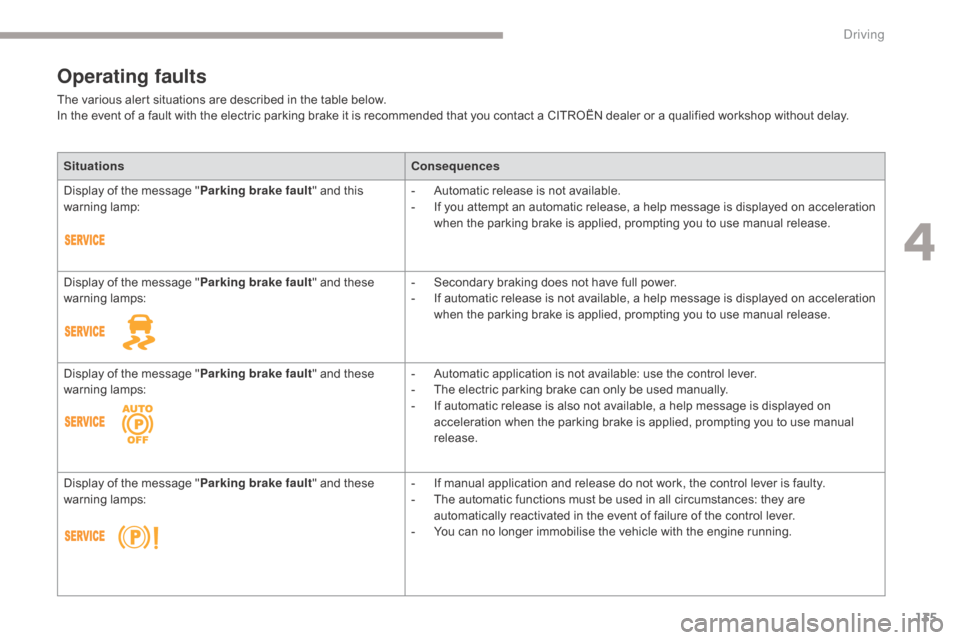
135
Operating faults
The various alert situations are described in the table below.
In the event of a fault with the electric parking brake it is recommended that you contact a CITROËN dealer or a qualified workshop without delay.Situations Consequences
Display of the message " Parking brake fault" and this
warning lamp: -
A
utomatic release is not available.
-
I
f you attempt an automatic release, a help message is displayed on acceleration
when the parking brake is applied, prompting you to use manual release.
Display of the message " Parking brake fault" and these
warning lamps: -
S
econdary braking does not have full power.
-
I
f automatic release is not available, a help message is displayed on acceleration
when the parking brake is applied, prompting you to use manual release.
Display of the message " Parking brake fault" and these
warning lamps: -
A
utomatic application is not available: use the control lever.
-
T
he electric parking brake can only be used manually.
-
I
f automatic release is also not available, a help message is displayed on
acceleration when the parking brake is applied, prompting you to use manual
release.
Display of the message " Parking brake fault" and these
warning lamps: -
I
f manual application and release do not work, the control lever is faulty.
-
T
he automatic functions must be used in all circumstances: they are
automatically reactivated in the event of failure of the control lever.
-
Y
ou can no longer immobilise the vehicle with the engine running.
4
Driving
Page 138 of 523
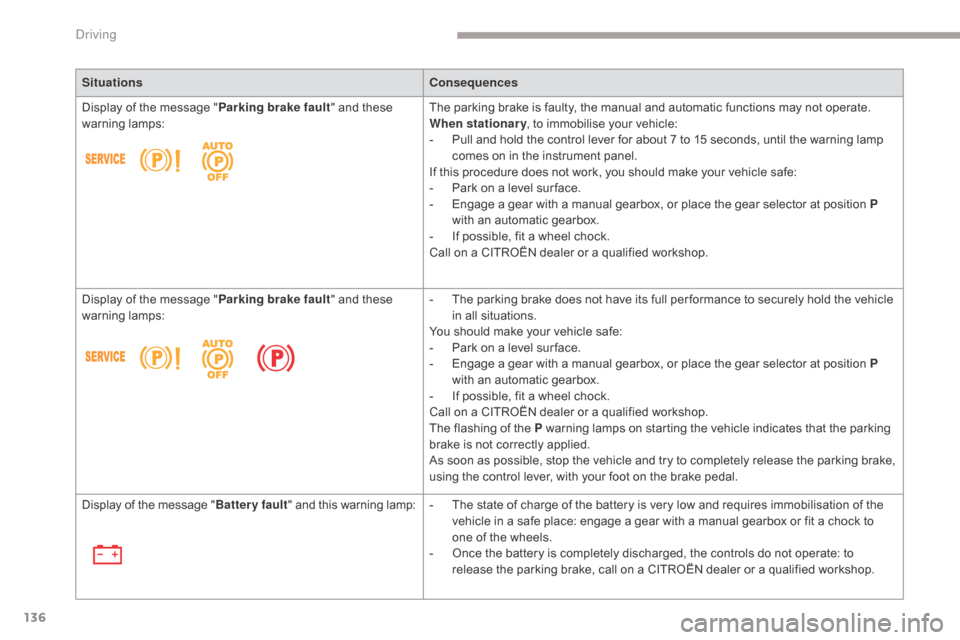
136
SituationsConsequences
Display of the message " Parking brake fault" and these
warning lamps: The parking brake is faulty, the manual and automatic functions may not operate.
When stationary
, to immobilise your vehicle:
-
P
ull and hold the control lever for about 7 to 15 seconds, until the warning lamp
comes on in the instrument panel.
If this procedure does not work, you should make your vehicle safe:
-
P
ark on a level sur face.
-
E
ngage a gear with a manual gearbox, or place the gear selector at position P
with an automatic gearbox.
-
I
f possible, fit a wheel chock.
Call on a CITROËN dealer or a qualified workshop.
Display of the message " Parking brake fault" and these
warning lamps: -
T
he parking brake does not have its full per formance to securely hold the vehicle
in all situations.
You should make your vehicle safe:
-
P
ark on a level sur face.
-
E
ngage a gear with a manual gearbox, or place the gear selector at position P
with an automatic gearbox.
-
I
f possible, fit a wheel chock.
Call on a CITROËN dealer or a qualified workshop.
The flashing of the P warning lamps on starting the vehicle indicates that the parking
brake is not correctly applied.
As soon as possible, stop the vehicle and try to completely release the parking brake,
using the control lever, with your foot on the brake pedal.
Display of the message " Battery fault" and this warning lamp: -
T
he state of charge of the battery is very low and requires immobilisation of the
vehicle in a safe place: engage a gear with a manual gearbox or fit a chock to
one of the wheels.
-
O
nce the battery is completely discharged, the controls do not operate: to
release the parking brake, call on a CITROËN dealer or a qualified workshop.
Driving
Page 139 of 523
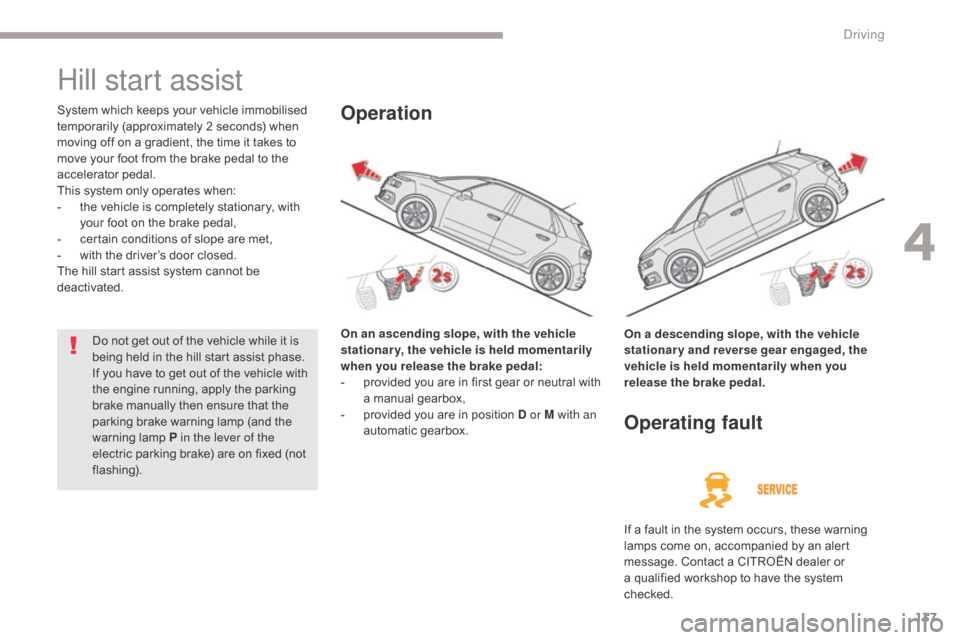
137
Hill start assist
System which keeps your vehicle immobilised
temporarily (approximately 2 seconds) when
moving off on a gradient, the time it takes to
move your foot from the brake pedal to the
accelerator pedal.
This system only operates when:
-
t
he vehicle is completely stationary, with
your foot on the brake pedal,
-
c
ertain conditions of slope are met,
-
w
ith the driver’s door closed.
The hill start assist system cannot be
deactivated.
On an ascending slope, with the vehicle
stationary, the vehicle is held momentarily
when you release the brake pedal:
-
p
rovided you are in first gear or neutral with
a manual gearbox,
-
p
rovided you are in position D or M with an
automatic gearbox.Operation
On a descending slope, with the vehicle
stationary and reverse gear engaged, the
vehicle is held momentarily when you
release the brake pedal.
Operating fault
If a fault in the system occurs, these warning
lamps come on, accompanied by an alert
message. Contact a CITROËN dealer or
a qualified workshop to have the system
checked.
Do not get out of the vehicle while it is
being held in the hill start assist phase.
If you have to get out of the vehicle with
the engine running, apply the parking
brake manually then ensure that the
parking brake warning lamp (and the
warning lamp
P in the lever of the
electric parking brake) are on fixed (not
flashing).
4
Driving
Page 140 of 523
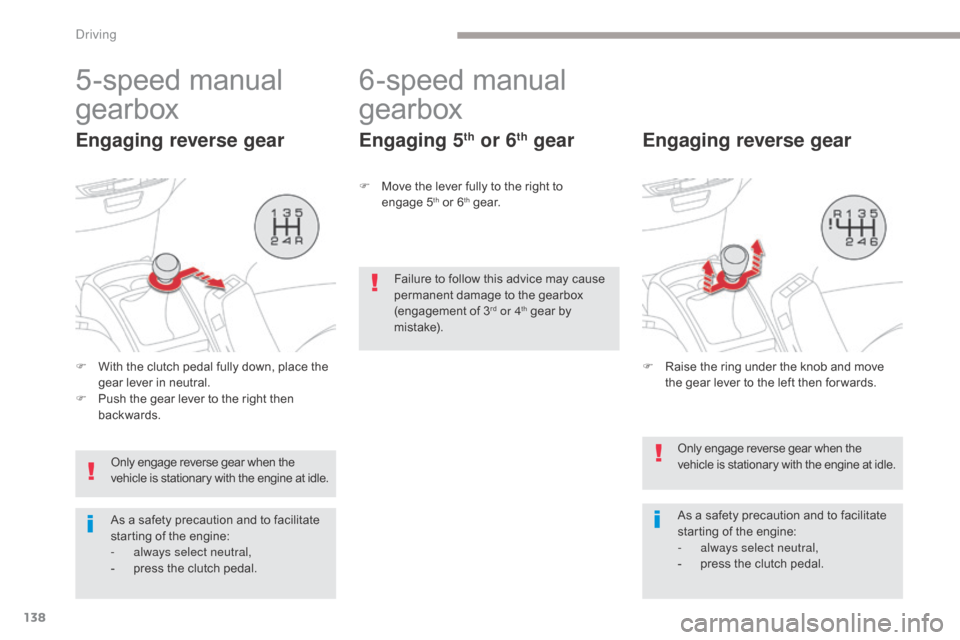
138
5-speed manual
gearbox
Engaging reverse gear
F With the clutch pedal fully down, place the gear lever in neutral.
F
P
ush the gear lever to the right then
backwards.
Only engage reverse gear when the
vehicle is stationary with the engine at idle.
As a safety precaution and to facilitate
starting of the engine:
-
a
lways select neutral,
-
p
ress the clutch pedal.
6-speed manual
gearbox
Engaging 5th or 6th gear
F Move the lever fully to the right to engage 5th or 6th g e a r.
Only engage reverse gear when the
vehicle is stationary with the engine at idle.
As a safety precaution and to facilitate
starting of the engine:
-
a
lways select neutral,
-
p
ress the clutch pedal.
Engaging reverse gear
Failure to follow this advice may cause
permanent damage to the gearbox
(engagement of 3
rd or 4th gear by
m i st a ke).
F
R
aise the ring under the knob and move
the gear lever to the left then for wards.
Driving